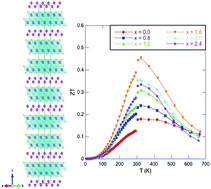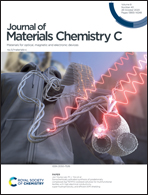Low-temperature transport properties of n-type layered homologous compounds Bi8−xSbxSe7†
Abstract
Chalcogenide semiconductors and semimetals are a historical fertile class of materials for discovering novel compounds for energy conversion applications, such as photovoltaic cells or thermoelectric devices. Here, we report on a detailed investigation on the low-temperature transport properties (5–300 K) of n-type series Bi8−xSbxSe7 (0 ≤ x ≤ 2.4), the thermoelectric performances of which can be optimized around 300 K. The complex layered crystal structure, built up by Bi bilayers and quintuple Bi–Se layers stacked perpendicular to the c axis of the trigonal unit cell, gives rise to very low lattice thermal conductivity κL values in the order of 0.6 W m−1 K−1 at 300 K. Upon cooling, κL(T) exhibits a crystal-like behavior with a well-defined dielectric maximum. Despite Sb and Bi being isovalent, both the thermopower α and the electrical resistivity ρ vary upon increasing the Sb content, possibly due to the variations in the nature and concentration of the native defects. Our results indicate the existence of two substitutional ranges, in which the evolution of the electronic properties with x is not equivalent. Combined with the poor ability of these materials to conduct heat, the high power factors, optimized for x = 1.6, result in a maximum dimensionless thermoelectric figure of merit ZT as high as 0.40 at 300 K, making these compounds competitive among n-type thermoelectric chalcogenides for near-room-temperature thermoelectric applications.



 Please wait while we load your content...
Please wait while we load your content...